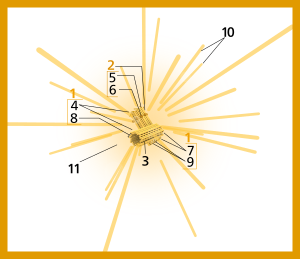Centrosome
| Cell biology | |
|---|---|
| centrosome | |
 Components of a typical centrosome:
|
In
Centrosomes are composed of two
In many cell types, the centrosome is replaced by a cilium during cellular differentiation. However, once the cell starts to divide, the cilium is replaced again by the centrosome.[11]History
The centrosome was discovered jointly by Walther Flemming in 1875 [12][13] and Edouard Van Beneden in 1876,[14][13] and later described and named in 1888 by Theodor Boveri.[15]
Functions

Centrosomes are associated with the
The mother centriole, the older of the two in the centriole pair, also has a central role in making
The centrosome is copied only once per

Centrioles, however, are not required for the progression of mitosis. When the centrioles are irradiated by a laser, mitosis proceeds normally with a morphologically normal spindle. Moreover, development of the fruit fly Drosophila is largely normal when centrioles are absent due to a mutation in a gene required for their duplication.[18] In the absence of the centrioles, the microtubules of the spindle are focused by motors, allowing the formation of a bipolar spindle. Many cells can completely undergo interphase without centrioles.[10]
Unlike centrioles, centrosomes are required for survival of the organism. Cells without centrosomes lack radial arrays of
When the nematode C. elegans egg is fertilized, the sperm delivers a pair of centrioles. These centrioles will form the centrosomes, which will direct the first cell division of the zygote, and this will determine its polarity. It's not yet clear whether the role of the centrosome in polarity determination is microtubule-dependent or independent.
In human reproduction, the sperm supplies the centriole that creates the centrosome and microtubule system of the zygote.[19]
Centrosome alterations in cancer cells
Theodor Boveri, in 1914, described centrosome aberrations in cancer cells. This initial observation was subsequently extended to many types of human tumors.[20] Centrosome alterations in cancer can be divided in two subgroups — i.e., structural or numeric aberrations — yet both can be found simultaneously in a tumor.
Structural aberrations
Usually, structural aberrations appear due to uncontrolled expression of centrosome components, or due to post-translational modifications (such as phosphorylations) that are not adequate for the components. These modifications may produce variations in centrosome size (usually too large, due to an excess of pericentriolar material). In addition, because centrosomal proteins have a tendency to form aggregates, centrosome-related bodies (CRBs) are often observed in ectopic places.[21] Both enlarged centrosomes and CRBs are similar to the centrosomal structures observed in tumors.[22] Even more, these structures can be induced in culture cells by overexpression of specific centrosomal proteins, such as CNap-1 or Nlp.[21][23] These structures may look very similar, yet detailed studies reveal that they may present very different properties, depending on their proteic composition. For instance, their capacity to incorporate γ-TuRC complexes (see also: γ-tubulin) can be very variable, and so their capacity to nucleate microtubules[22] therefore affects the shape, polarity and motility of implicated tumor cells in different ways.
Numeric aberrations
The presence of an inadequate number of centrosomes is very often linked to the appearance of
Evolution
The
It is evident that some parts of the centrosome are highly diverged in the model species
Associated nucleotides
Research in 2006 indicated that centrosomes from Atlantic surf clam eggs contain RNA sequences. The sequences identified were found in "few to no" other places in the cell, and do not appear in existing genome databases. One identified RNA sequence contains a putative RNA polymerase, leading to the hypothesis of an RNA-based genome within the centrosome.[30] However, subsequent research has shown that centrosome do not contain their own DNA-based genomes. While it was confirmed that RNA molecules associate with centrosomes, the sequences have still been found within the nucleus. Furthermore, centrosomes can form de novo after having been removed (e.g., by laser irradiation) from normal cells.[29]
References
- ^ "Structure of Plants and Fungi|Digitális Tankönyvtár". regi.tankonyvtar.hu (in Hungarian). Retrieved 2021-01-30.
- ^ PMID 17977464.
- PMID 12224551.
- PMID 15473833.
- PMID 16546079.
- PMID 22223737.
- ^ staff (5 January 2012). "Flatworms' minimalist approach to cell division reveals the molecular architecture of the human centrosome" (press release). Stowers Institute for Medical Research. Retrieved 6 January 2012.
{{cite journal}}: Cite journal requires|journal=(help)[permanent dead link] - from the original on 2021-07-25. Retrieved 2020-08-07.
- PMID 1967194.
- ^ PMID 11567874.
- PMID 24982683.
- ^ Flemming, W. (1875). Studien uber die Entwicklungsgeschichte der Najaden. Sitzungsgeber. Akad. Wiss. Wien 71, 81–147
- ^ PMID 20362083.
- ^ Van Beneden, E. (1876). Contribution a l'histoire de la vesiculaire germinative et du premier noyau embryonnaire. Bull. Acad. R. Belg (2me series) 42, 35–97.
- ^ Boveri, Theodor (1888). Zellen-Studien II: Die Befruchtung und Teilung des Eies von Ascaris megalocephala. Jena: Gustav Fischer Verlag. Archived from the original on 2021-08-26. Retrieved 2018-01-14.
- S2CID 1622118.
- S2CID 6965044.
- ^ S2CID 2080684.
- ISBN 978-0-7817-3769-2. Archivedfrom the original on 2024-03-21. Retrieved 2013-11-09.
- ^ S2CID 9038803.
- ^ PMID 12852856.
- ^ PMID 11830638.
- PMID 9647649.
- PMID 10612807.
- from the original on 2020-11-15. Retrieved 2019-09-09.
- PMID 11847097.
- S2CID 11985415.
- S2CID 1415623.
- ^ PMID 19196504.
- PMID 16754862.
